|
The Queenslander
Introduction
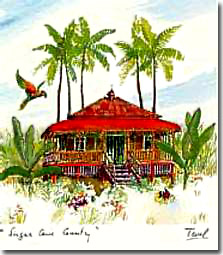
To most Australians a tropical house conjures a vision of a large sprawling structure on round timber stumps with an extensive deep, shaded verandah filled with trellis and a blaze of colour spread by a bougainvillaea creeper, with a tall mango tree or two shading its red corrugated iron roof.
The Queensland house represents a distinctive style of architecture. It also speaks more eloquently than almost anything else about this state's distinctive lifestyle. Queensland does not have one particular type of housing. However, it does have a dominant tradition of timber building which evolved continuously from the rude timber hut of early settlement to the multi-gabled bungalow of the 1930s and beyond.
There is an open friendliness about these houses which, like their owners, is characteristic of the warmer regions of Australia which comprise well over seventy per cent of this vast continent. They reflect a lifestyle which is a unique expression of the way people have adapted themselves to an environment vastly different from their historic European experience.
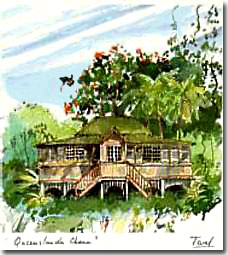 Queensland houses were usually constructed to face the street, irrespective of the direction of prevailing breezes. This factor, when combined with the high heat conductivity of tin iron and the poor insulating qualities of timber, exacerbated the problem of Queensland's heat. Queensland houses were usually constructed to face the street, irrespective of the direction of prevailing breezes. This factor, when combined with the high heat conductivity of tin iron and the poor insulating qualities of timber, exacerbated the problem of Queensland's heat.
The more affluent were less prone to this situation as they could take better account of the prevailing breezes. To create airflow, windows and doors were left open, leaving the occupants prey to insects and animal pests. To reduce the numbers of these creatures, trees and brushwood were cleared from the land.
The elements which gave distinctiveness to the Queensland house, materials of predominantly timber and corrugated iron, the light construction which arranged those materials into the typical form we know, and the different settings and suburbs in which these houses were located, all helped to develop the differing styles that we see before us today. Miners or workers cottages, urban homes, bungalows, colonials, all had a place in the developing society of Queensland and were somewhat dependant on either locale or class structure that existed at the time.
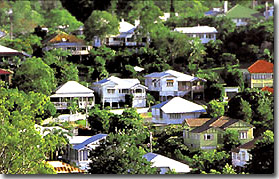 David Malouf wrote of one home he knew: David Malouf wrote of one home he knew:
Edmonstone Street was a one storeyed weatherboard, a style of house so common then as to be unremarkable, Brisbane was a one storeyed weatherboard town. It stood on low stilts at the front, high stilts at the back and was essentially a nest of open rooms surrounded on three sides by wide, cooling verandahs, ironwork to the rails, in a pattern of interlocking circles, and rolled venetians above. The ironwork was cream, the verandahs ochre, the square wooden supports with their branches and volutes a spanking white, and the roof which was iron, that dull ox-blood colour that is so peculiar to Brisbane that it seems more dominant even, in the long view, than the green of the enormous shade trees.
So what of style? What makes up these typical Queensland homes?
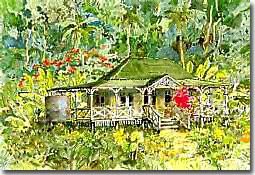 The house on stumps has long been regarded characteristically as the Queenslander. A number of explanations have been advanced as to the origins of the high stump house and the advantages of living in one. More often than not, it seems, that by lifting these structures above the ground, it is easier for the owner to detect any white ant or borer infestation and take action. Some people comment favourably on the merits of the house on stumps, they maintain that such houses are well positioned above mosquitoes, snakes, cane toads and floods, and that furthermore they catch welcome cool breezes. The house on stumps has long been regarded characteristically as the Queenslander. A number of explanations have been advanced as to the origins of the high stump house and the advantages of living in one. More often than not, it seems, that by lifting these structures above the ground, it is easier for the owner to detect any white ant or borer infestation and take action. Some people comment favourably on the merits of the house on stumps, they maintain that such houses are well positioned above mosquitoes, snakes, cane toads and floods, and that furthermore they catch welcome cool breezes.
Extracts from the book The Queensland House have been used here.
Information on this book can be obtained by contacting the
Queensland Museum.
paintings by Téval
Continue 
|


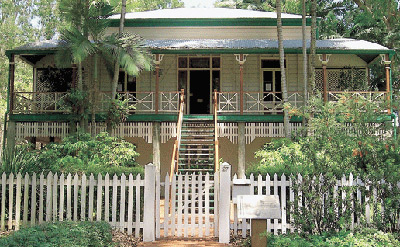
 Queensland houses were usually constructed to face the street, irrespective of the direction of prevailing breezes. This factor, when combined with the high heat conductivity of tin iron and the poor insulating qualities of timber, exacerbated the problem of Queensland's heat.
Queensland houses were usually constructed to face the street, irrespective of the direction of prevailing breezes. This factor, when combined with the high heat conductivity of tin iron and the poor insulating qualities of timber, exacerbated the problem of Queensland's heat.
 David Malouf wrote of one home he knew:
David Malouf wrote of one home he knew:  The house on stumps has long been regarded characteristically as the Queenslander. A number of explanations have been advanced as to the origins of the high stump house and the advantages of living in one. More often than not, it seems, that by lifting these structures above the ground, it is easier for the owner to detect any white ant or borer infestation and take action. Some people comment favourably on the merits of the house on stumps, they maintain that such houses are well positioned above mosquitoes, snakes, cane toads and floods, and that furthermore they catch welcome cool breezes.
The house on stumps has long been regarded characteristically as the Queenslander. A number of explanations have been advanced as to the origins of the high stump house and the advantages of living in one. More often than not, it seems, that by lifting these structures above the ground, it is easier for the owner to detect any white ant or borer infestation and take action. Some people comment favourably on the merits of the house on stumps, they maintain that such houses are well positioned above mosquitoes, snakes, cane toads and floods, and that furthermore they catch welcome cool breezes.